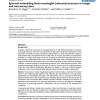Free Online Productivity Tools
i2Speak
i2Symbol
i2OCR
iTex2Img
iWeb2Print
iWeb2Shot
i2Type
iPdf2Split
iPdf2Merge
i2Bopomofo
i2Arabic
i2Style
i2Image
i2PDF
iLatex2Rtf
Sci2ools
BMCBI
2006
2006
Spectral embedding finds meaningful (relevant) structure in image and microarray data
Background: Accurate methods for extraction of meaningful patterns in high dimensional data have become increasingly important with the recent generation of data types containing measurements across thousands of variables. Principal components analysis (PCA) is a linear dimensionality reduction (DR) method that is unsupervised in that it relies only on the data; projections are calculated in Euclidean or a similar linear space and do not use tuning parameters for optimizing the fit to the data. However, relationships within sets of nonlinear data types, such as biological networks or images, are frequently mis-rendered into a low dimensional space by linear methods. Nonlinear methods, in contrast, attempt to model important aspects of the underlying data structure, often requiring parameter(s) fitting to the data type of interest. In many cases, the optimal parameter values vary when different classification algorithms are applied on the same rendered subspace, making the results of s...
| Added | 10 Dec 2010 |
| Updated | 10 Dec 2010 |
| Type | Journal |
| Year | 2006 |
| Where | BMCBI |
| Authors | Brandon W. Higgs, Jennifer W. Weller, Jeffrey L. Solka |
Comments (0)

